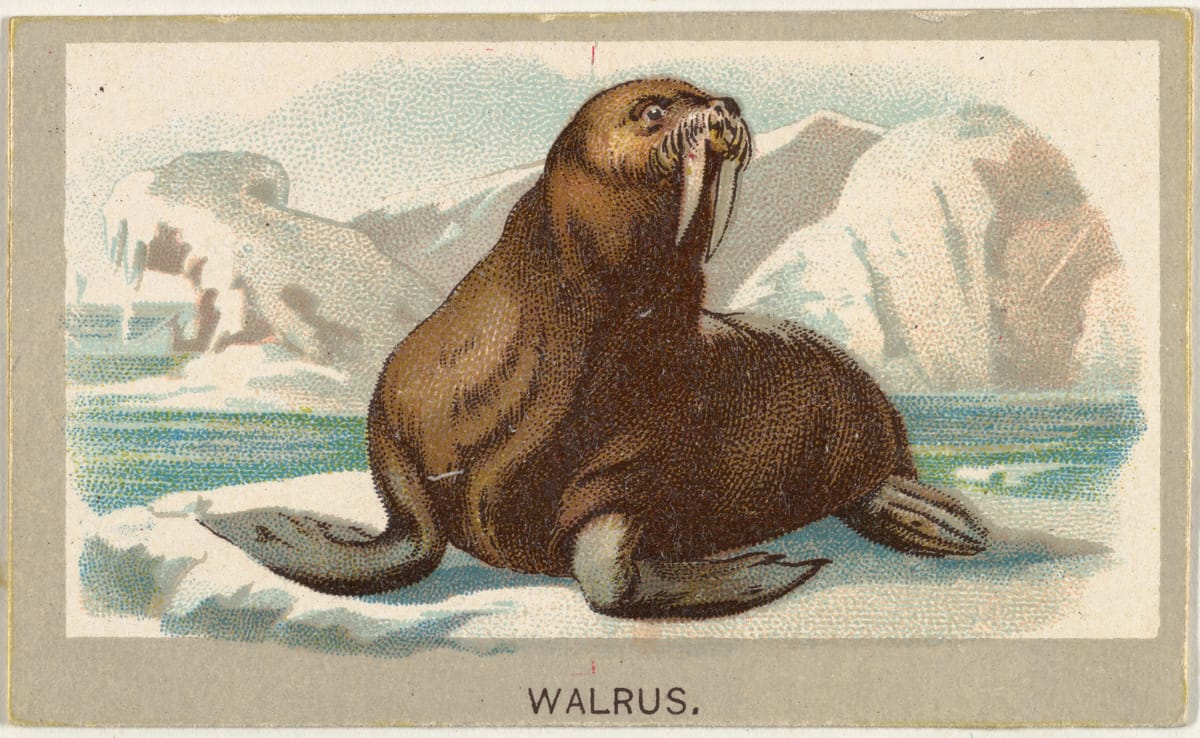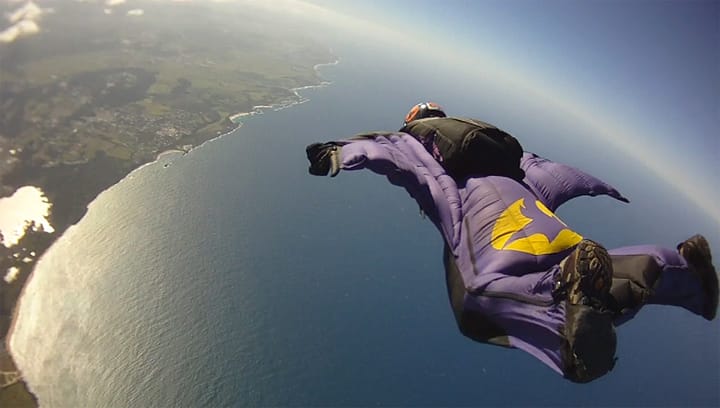fairy or walrus? futuring tips from the Tumblrati
This is the hill I will die on today: the kids on Tumblr are currently engaging more seriously with the boundless possibilities of futurity than the Very Serious AI Guys of LinkedIn.

It seems like a long time since I last read a “here’s a thing people are doing on the internet this week” article and found the behaviour being described to be for the most part wholesome, quirky and delightful… but I guess I can reset that particular counter.
What happened is that someone on Tumblr asked whether, on answering an unexpected knock at your door, you would be more surprised to find a fairy on your doorstep, or a walrus.
The question went viral, somewhat to the consternation of the original poster: most people chose the fairy as most surprising option, and that was not the OP's preferred answer. Of more relevance to this essay, however, was the resulting rolling discussion of (im)possibility and expectations, which has prompted me to propose my very own clickbait-y claim:
The people asking “fairy or walrus?” on Tumblr are doing better futures exercises than the people on LinkedIn arguing over how many creative jobs are or aren’t about to be destroyed by LLMs.
“C’mon now, Paul,” you might reply. “We know you’re sick to the back teeth of people bullshitting their way aboard the runaway gravy-train, but unlike this whole fairy-or-walrus thing, it’s not crazy.”
And you’d be right—I am utterly sick of The AI Discourse™! You’d also be right that, by comparison to the fairy-or-walrus thing, The AI Discourse™ is not crazy.
But that’s exactly why the fairy-or-walrus discourse is better futures practice.
To make my case, I’m going to draw on the work of a far better and more experienced foresight thinker than myself—one of the truly great practitioners, in fact.
A little under a decade ago, the mighty Wendy Schultz published a paper titled “Crazy Futures: Why Plausibility is Maladaptive”. In her attack on the hegemony of the plausible in futures work, she wasted little time in getting to a defence of the implicit opposite of the plausible, namely ‘the crazy’.
… if we define ‘crazy’ by contrast with ‘normal’, then it is the unusual as contrasted against the usual. ‘Crazy’ is subjectively relative to internal expectations filtered and biased by milieu, culture, and technological setting, among other things. That is precisely its utility to futures thinking. ‘Crazy’ – and the sense of nervous apprehension it engenders in viewers – highlights and problematizes the assumptions and points of view that compose the normal. If the various futures we face are composed of surprises, of novelty – of the abnormal – then crazy is just what we need: it exposes our blind spots, the dangerous limitations of our assumptions.
It’s not a short paper, and there’s a whole bunch of stuff in the middle about the rise of plausibility as a criterion of excellence in futuring. As someone who makes a bee-line for the etymological dictionary at the slightest provocation, let me tell you, I am fully here for it when Wendy unearths what she labels the “professional vulnerability that all futures researchers face in practicing an intellectual discipline for which there are no future facts, in a world of decision-makers hungry for an evidence base”.
Basically, plausibility feels like a safe space to run to when you’re worried that the client is going to think you’re a charlatan… and given that the perception of any given future as appealing or unappealing, utopian or dystopian, is at least to some extent subjective, then that’s a real risk.
But it gets worse!
It is not just the image [of the future] itself that is judged. ‘Crazy futures’ often earn that label, despite being prosaic and mundane in content, if they have transgressed in process.The current decision-making environment for many economic, political, and social issues is instrumentalist, evidence-based and biased towards Western empiricism. Sadly, a field that engages in research despite lacking an ability to observe its subject directly (until such time as tachyon-powered time machines or traversable wormholes enable field research in the futures) often lacks credibility as well.
So, you might reasonably ask, wouldn’t it be wise to throw out all the crazy futures, and keep things plausible? You don’t wanna swim against that epistemic tide, after all!
Actually, says Wendy, swimming against the tide is exactly what you should do, because the one thing we know for sure is that “we are embedded in—and are ourselves—complex systems flirting daily with chaos”, and complex systems inevitably eventually arrive at ‘crazy’ states or exhibit ‘crazy’ behaviour, especially in response to external stressors. As such:
… a focus on ‘crazy futures’ may be the most adaptive strategy we can encourage people to adopt, and a focus on ‘plausibility’ the most maladaptive. Is your future crazy enough to help you, your organization, your community evolve? Better that we rehearse the full range of surprises that may await us across our futures, than be ill-prepared and unable to adapt. Emergence and evolution are preferable to equilibrium.

Now, I think it’s interesting to note that Wendy's paper is from 2015, at which time I was wading uphill through wet concrete trying to persuade civil engineering academics that narrative methods were a useful adjunct to more traditional and quantitative forms of foresight in infrastructure planning. It was a tough time to be making that argument! I assume that, given Wendy was motivated to write this paper, it was also a challenging time to be arguing in favour of ‘crazy’ futures, at least in some spaces.
But it was also the time at which the design fiction scene was just starting to get its feet under itself, as well as a period during which a whole array of the Anglophone interpretive social sciences (and, to a lesser extent perhaps, the humanities) were rediscovering futurity as a domain of enquiry, having previously been ousted from it during the mid-to-late C20th by the vigorous mutant progeny of the RAND Corporation, whether by way of epistemic humiliation (i.e. scientism and the associated fetish for the quantitative), by way of accusations of communism, or (ideally) by some combination of the two.
(If you want to explore the history of futures as a practice, and as a site of epistemic struggle, I can heartily recommend Andrew Curry’s excellent opening essay in the Routledge Handbook of Social Futures, and John Urry’s last book What is the Future?, which should be a must-read for anyone in the field.)
Point being: around the time Wendy was giving the talk that became this paper, a whole bunch of funky creative methods were starting to get traction, slowly putting crazy futures firmly back on the agenda. Indeed, I’d argue that by the dawn of the decade, just five years after Wendy's paper, crazy futures were actually in the ascendant.
And, well—we all know what happened then. We could probably have a good argument about who did or didn’t file a global pandemic in the ‘crazy futures’ basket, and whether those who did were using ‘crazy’ in the GBN get-out-of-my-boardroom sense of the term, or in Wendy’s more provocative and thoughtful formulation.
Back in 2015 or so, when I sometimes found myself hanging at the lobby track at tech or art (or tech-art) conferences with various notables from the design fiction scene of the time, we used to joke that the problem with doing our sort of work was the challenge of convincing the client that the world was sufficiently uncertain to merit asking us for help with thinking about their strategy. Thanks to not just the pandemic but a whole wagon-train of other stuff, we don’t need to do that any more; the world has made the case for that sort of crazy on our behalf.
Unfortunately, in so doing, it has also made the economic situation so uncertain that, while everyone worth working with recognises that the long view needs looking at, hardly anyone is willing to be the first to peek over the horizon of next year’s budget.
And so it goes! Cue some wise-guy in the audience shouting “didn’t predict that, did ya, Mister Futurist?”
That guy will always be with us... and so will the “but is it plausible?” guy. The difference is that the plausibility guy is an obstacle to our work, an obstreperous chunk of the status quo that needs clearing away, while the guy who just can’t resist reminding us that we’re not prophets is actually kinda useful to have around, even if he can be annoying.
(I know that guy can be annoying, because I’ve been him—and believe me, people made the effort to let me know I was annoying.)
So, back to Wendy one last time, for the best possible argument in favour of making weird shit:
In order to thrive in whatever futures we pass through, it helps to rehearse what our values, assumptions, decisions and actions - our very sense of self - might be in those futures. Authenti rehearsal inevitably requires that at some level we choose to believe not only what is plausible, and not just what is probable or possible, but that we stretch our values, assumptions, and sense of self to believe and rehearse for the impossible as well.
Now, this is exactly why when I see the Tumblrati asking “fairy or walrus?”, I see people who are probably better prepared for a future in which things get more weird more quickly than some guy with an MBA from Stanford. Asking yourself “fairy or walrus?” is going to stretch your imagination, your sense of the world and your sense of yourself, waaaaay more than asking yourself “what if 2% less growth in Q3 next year?”
(Granted, you might want to make your choice of imaginary door-to-door hustlers slightly more pertinent to your particular goals… and you might want to make the imaginative exercise a little bit more structured and extensive than an online comment thread. But as luck would have it, that sort of work just happens to be exactly what critical creative foresight practitioners are good at! So why not get in touch with one and ask them about it, hmm?)





Comments ()